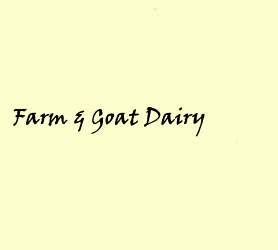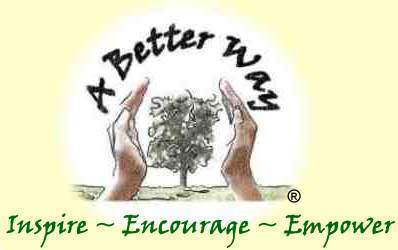Ok, you have ORF in your herd, now what?
First off, what is ORF?
Orf (also known as contagious ecthyma, sore mouth or contagious pustular dermatitis) is a viral skin and mucosae disease which causes scabby lesions usually around the area of the mouth, lips and nose. You can find all kinds of information (good and bad) about it online, so I'm not going to repeat all that here. The purpose of this article is to share my experience with it in my herd, what I learned and how I handled it.
I always had heard "If you breed goats long enough, eventually you'll have to deal with sore mouth". And I would say to myself "Not me, we have a closed herd.". And we do... one of the most closed herds you could possibly imagine. I say that to tell you, no one is truly insulated. We had added NO new animals in 18 months when we got it, NO visitors to the farm in many months. The only reason I know HOW we even got it (which most will never figure out in their herds!), is because of the very unique way it started in my herd.
17 of my milking does came down with what I thought were Staph bumps on their left teats, and left teats only. Interesting to note that these does never did get bumps anywhere else on their body, just their left teats (more on that later). I wasn't too surprised to see those first bumps... because I had made a mistake about 7 days prior and realized it. I corrected my mistake, but noted it as well. I was tossing a ball to my small dog while I was milking (concrete floors) to keep her occupied... and without thinking about it, I grabbed the ball from her mouth with my gloved hand, tossed it, she went running after, and then I put my gloved hand right back on the doe's teat to finish stripping her out. I actually did it a few times before I caught myself and thought to myself yeah, I shouldn't be doing that... bacteria from the ball to the doe's teat isn't smart. Just a simple slip of thought. Corrected my actions, no more ball while milking. Should have been a done deal... but when I saw the bumps on several does left teats about 7 days later, the same hand I used to grab the ball... I knew where that came from! What I never did imagine though, at that point, was that it could be ORF! Each day, I was noticing more of my milkers had the bumps on their left teats. Sigh. Still figured Staph, figured it was transferred by the inflations I use to milk the does. In less than a week, 17 does had at least a minimal bump on their left teat. Some had more though and it was starting to look weird. Like more than what Staph could look like. It looked like ORF to me, but that couldn't be possible!!! How could it?!?! On a teat!?!? and just one!?!? and not anywhere else on their bodies!?!? not their mouth or anywhere, just a single teat!?!? couldn't be, right?!?!
I had the vet out to look at it and he was in disbelief too. He's seen a lot of ORF cases and never nothing like 17 does getting it on one teat and one teat only, that doesn't even make sense for ORF! At my insistence, he took some samples of the bumps and sent them off for PCR testing for the ORF virus. Luckily, I pull all kids at birth and 100% bottle raise them in a separate nursery. My kids never nurse from a teat, so no chance I'd have any trying to nurse off their teats and spreading it. However, what DID happen, is before I realized what it was, I was putting out excess milk in buckets (as I always do) to the does to drink. Interestingly, it took a few weeks before I saw my first cases of does with a scab in the corner of their mouth. I believe that is because the milk wasn't infected until the bumps on their teats had become scabby, which was close to a week after seeing the first bumps. And then from that exposure to the milk, at that point, another week before popping up in some does that drank it. At the same time I was noticing a few had small abrasions in the corners of their mouths, the PCR test came back positive for ORF. A false positive is not possible with that test. It was indeed ORF and I had yet more evidence in front of me by then, so I knew it was correct.
So I know it came from the ball, to my hand, to the doe's teat. Thats how it started in my herd. Now, how did it get on the ball though!?!? Well, one of two possibilities there. Either my dog was an asymptomatic carrier (she had been to the vet about a week earlier) and she infected the ball, or the ball rolled next to the feed bags from the feed store and somehow a tiny fragment of ORF could have been on a feedbag (from someone's shoe to the floor at the store and then to the feedbag placed on that same spot of floor for example), then from the feedbag to my floor, to the ball. Thats it. Those are the only two possibilities. We had zero visitors here at that point in many months, no new additions in way over a year, it definitely came from that ball, to my hand, to the left teats... if it had started in my herd any other way, I may not have been able to isolate how it started/where it came from... but with it starting specifically on the left teats of so many does is how I was able to isolate how it started. It really goes to show you, you really can't 100% insulate yourself! I have a closed herd!
Most does only got a small bump in the corner of their mouth, I actually had to feel for most of them because they were so minor. My guess there is the method of delivery. Something about them getting it from the milk possibly made it extremely mild. The does that had it on their left teats never got it anywhere else. What I learned about that is that for them, it basically acted like giving them the live vaccine... on their left teats. It worked. But the live vaccine is just that, live. The crusts from the sores that the live vaccine makes are contagious... and that is exactly what happened, some tiny bit of scab ended up in the milk which the herd then drank. So I knew what I was dealing with at that point. My next step was how to deal with it.
I started charting each doe and the date she showed symptoms. I knew that they become immune from it once having it... and it definitely wasn't anywhere near as scary as some of the horrid pics I saw online. It was actually very unextraordinary. So I went about making sure everyone got it as soon as possible to get us cleared by the end of the year so I could do a complete cleanout and sanitization of the barn... before our next kidding season. That was step one.
Step two was to make a decision on how I wanted to handle it publically, business wise. This was actually the much harder decision. Its a funny thing, the dairy goat world.... all the long time breeders will tell you, you'll have to deal with sore mouth eventually, but none seem to be open about saying how they know that... because they too at some point had to deal with it. Its this whole weird hush-hush culture about it. It didn't sit right with me to be that way about it. It seemed dishonest to me. Even though I wasn't selling anything at the time and we'd be 100% clear before anything was leaving out the door... it just didn't sit with me right to do something I don't agree with. I believe in being open and honest about all aspects of what I do here... and I have a saying I live by... "The true measure of integrity isn't simply having it when its easy, but maintaining it even when its very difficult to do so.". And so here was a really good test of my integrity. I'm proud to say, I stood strong and maintained my integrity, even though it wasn't the easier thing to do. I did it for two reasons. One, because I feel its really important to be completely open and honest about my goats and business with my customers but also, the other reason was because I didn't want to continue the hush hush culture when I could actually possibly help others in the future with my experience.
I set about personally contacting every single person that had reservations with me, which was well over 60 people, telling them what was happening and offering to refund their reservation fee. I think my openness and honesty about something most would hide, actually helped them trust me more. To my surprise, most decided to keep their reservations with me. One funny one to note... one customer decided she didn't want to take a risk that the goats could carry it for their lifetime and infect her goats. Which I totally respect... but here is the funny part, she had goats from a breeder that I personally talked to, that kept her outbreak hush hush, and that had an ongoing outbreak for 2 years because of when it first happened, and not having a chance to get everyone cleared at once and decontaminating everything... so the funny part was that lady already had does there that had ORF before... she just didn't know it because the other breeder hadn't disclosed... and thats actually why I'm saying all this... if you have bought adult does from various breeders... chances are REALLY good that you already have does in your herd that were at some point exposed (and became immune to) ORF.
Another super interesting tid-bit!!!... The ONLY does that did not get any signs of it in my herd, AND did not react to the vaccine (which I tried to give to the ones that hadn't shown signs to hurry up and expose everyone)... were.... you want to guess????..... does that I had bought as adults!!!! They were already immune. You will find online where it says they carry it for life and can infect other goats, but after talking with many breeders that have actually dealt with it, this must be some kind of rare exception... or if you notice, all those webpages, do seem to be a copy and paste of the same exact text... so a page said it somewhere, and that became the gosphel?? I'm not sure, but if you talk to breeders that have actually dealt with it, they will tell you what I have found... they become immune and don't get it again when exposed. Period.
My guess would be its WAY more likely that perhaps some don't build up full immunity from it and can be infected again later. Plus it is known that there are different strains... so those goats that "get it again", are likely infected with a different strain and because people often "have no idea" how it got into their herd, its prob the easier thing to blame "oh well I heard that goat had it before, she must have been a carrier and thats how it started here".
HOW TO GET RID OF IT FOR GOOD
The next step, after everyone had been exposed and cleared was to do a COMPLETE and THOROUGH clean out and sanitization of the barn. All feeders, waterers, WALLS, surfaces, EVERYTHING. First EVERYTHING, and I do mean EVERYTHING, needs to be SCRUBBED thoroughly. It MUST be clean to be effectively sanitized. Bleach won't work if its not clean! I found research online about what chemicals kill it and it was a high concentration bleach, with instructions that it had to be sprayed until wet and allowed to air dry in order for it to kill the ORF organism. I didn't save that link, but best to look that up yourself anyhow to see what all the various options are. I want to say that chlorahexadine wasn't effective in that study - but definitely look it up... maybe I'm remembering wrong and I'll say if you do use the bleach method, make sure you have LOTS and LOTS of ventilation... and do it when the goats will be out of the barn all day. Beyond sanitizing every surface, top, bottom, sides, inside and out... all bedding came out, truly a reset in time. It took a LOT of labor and time, but it was worth it. It worked. I was able to eradicate it.
Can humans get it? Yes, they can... you should be careful and not touch the scabs... that said, I touched all over those scabs for a few weeks before I knew what they were, and I drank the same milk the goats drank! I never got it. I talked to other breeders that said basically the same, they were never careful around it and never got it. What I do know, is if your immune system is compromised in any way, you are susceptible. I know of two individuals with compromised immune systems that got it. One just had a sore on his thumb and that was it. The other one I only know she got it, not to what extent. Its best to take precautions either way.
I hope this write up will help other breeders that have found themselves in the unfortunate position of realizing they have ORF in their herd, going through all the panic and worry of what is going to happen next. It really is something that just needs to run its course. Make sure there are no secondary infections and it will be done and over with... as long as you do everything to eradicate any left over traces of it before more goats are brought in and/or born. All in all, its not an extreme disease. Its really not that scary at all. Do an extreme and thorough cleanout and santization of EVERY surface... and that will be that. If you are thinking about keeping it a secret... I do understand that is a personal decision... but also consider if even just one person knows, or finds out, they will very likely tell others, and it will spread, and that you are keeping it secret will make people distrust you. Understandably.
Here are pictures of some of the 17 does that had it on their left teats...

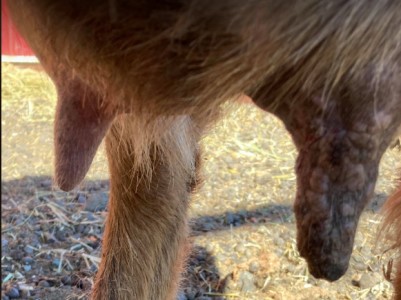
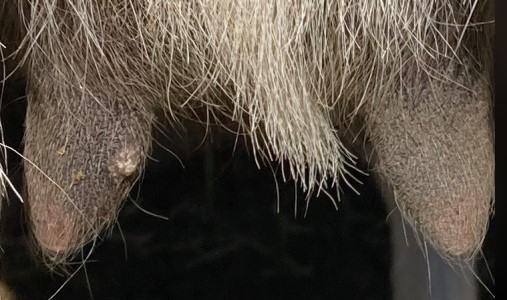
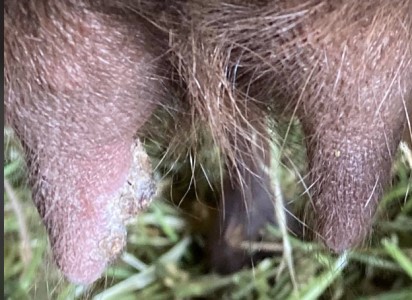

Would you like to read more about Goats and Goat Care? Check out the
Articles/Posts Index.
 |
I live on the side of a mountain with 65
goats and 4 dogs. I make 100% of my living from my homestead. My
purpose is to "Inspire,
Encourage & Empower". Read more about my story here.... |
Top Posts
- Goat Basics
- -Goats: Basic Terms & Facts
- -Goat Housing needs
- -Goat Fencing requirements
- -Goat Care Requirements
- -What Do Goats Eat?
- -Why Registered Goats?
- New Breeder Resources
- -ADGA Genetics Tool
- -Tips For Goat Setup Pics!
- -How To Lookup Milk Records
- Videos
- -Virtual Barn Tour
- -Kidding area & Nursery Tour
- -Goat Milk Parlor Tour
- -Low Cost CIP System Hack
- -Kidding - A Huge Single
- -Kidding - Head Only-no feet
- -Saving A Cold Newborn
- -Bottle Holder Rack Designs
- -Low Cost CIP System Hack
- Other Helpful Articles
- -Humane Euthanasia
- -Kidding Season Prep
- -Our Experience with ORF
